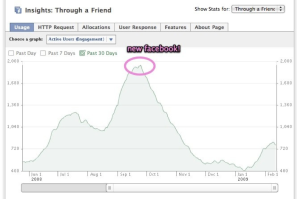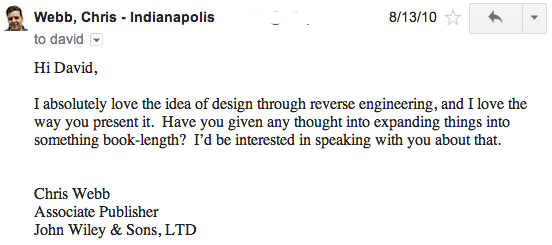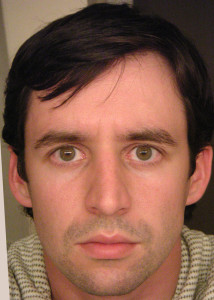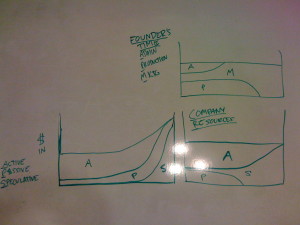Subscribe to blog updates via email »
A Bootstrapper’s Story: 10 Years of kadavy.net
Today marks the 10th year of the kadavy.net blog. As a natural way to commemorate an event like this, one might make a list of the top blog posts from all 10 years. (I’ve already shared the design evolution of kadavy.net.)
But I think the story that happened in between all of the blog posts is what’s significant about kadavy.net. Sure, the blog has been a great testing bed for web design and thought experimentation, and it’s lead to all of my biggest career wins, but more than anything, it’s been a vehicle for personal transformation.
I took this here #selfie just a few months after I started blogging on kadavy.net. My position in life at this time was one that is probably all-too-familiar for many readers. I was 25 years old, and I was using my college education to get paid $15 an hour to scan photos of my colleagues grandkids, or show them how to change the paper on the printer. (Though, really, I’d just have to do it for them.)

WANT TO WRITE A BOOK?
Download your FREE copy of How to Write a Book »
(for a limited time)
I felt stuck in my hometown of Omaha, Nebraska. I had dreamt of getting out since I was a kid, but – after traveling all over the country searching for a job – I was right back where I had started.
I spent a lot of time staring into the mirror, seeing what you’re seeing in that #selfie. I felt very compelled by my own reflection. Not because I thought I was super duper good-looking, but because I didn’t recognize the person I saw.
I thought I saw someone with talent, and promise, and something to offer the world. But, it didn’t feel like the world agreed with me.
I wanted badly for my life to change, but I had no idea how to make that happen. I could have just picked up and moved, but I was too timid-hearted for that – too risk-averse.
So, I spent the next 10 years making very calculated risks. From that, I’ve built the life that I had dreamt of – one of congruence of desire and action. I’ve written a best-selling book, built a business that allows me to pursue my curiosities, and I’ve done much of it while in various corners of the globe.
Creating the force for a change
I didn’t have the guts to make a drastic change, so I just tried to create enough force that a change would eventually happen. There were two things, it seemed, that would make that more likely.
One was to have enough money saved up that I wouldn’t be scared to make a leap. So, I ate $1 Banquet meals nearly every day. I ate them so often, I couldn’t go into the break room to heat them up without numerous coworkers teasing me for eating Banquet meals every day.
“You should just get married,” was a solution frequently offered for the blandness of my lunchtime ritual. (I’ll just offer that up without comment.)
Sometimes, the Banquet meals were on sale, 10 for $8, making them 80 cents. I socked away as much money as I could into an Ameritrade account, and maxed out my 401k. Ostensibly, I was saving for retirement, but the back of my brain would say “business, business!”
The other thing I could do to create force was work on my skills. I got to do some challenging interactive work amid the picture-scanning and paper-changing duties at my job, but I wanted my own place for experimentation. One where there was no client to meddle with my decisions, and no boss to fire me if I messed something up.
Inspired by the Flash experiments of Erik Natzke, I had previously posted my own Flash experiments, but now I was more interested in CSS. If you didn’t work with the web back in this time, it’s hard to imagine what a pain it was to work with CSS. There were still plenty of advocates for using tables instead of CSS for layout, and the cross-browser compatibility issues were bad enough that those people didn’t sound entirely crazy.
So, I took inspiration from David Shea’s CSS Zen Garden, and bloggers like Jason Santa Maria and Shaun Inman, and started a blog on blogger.com.
If you read my first blog post, you have to shake your head and wonder how I ever managed to write an entire book. It’s all a run-on paragraph, and there’s even a misspelling. I didn’t like writing at the time, and it showed.
I spent my nights and weekends experimenting and redesigning kadavy.net. In fact, I took an entire week’s vacation and sat on my couch from 10am–2am every day of that vacation, just working on my blog.
Getting “discovered,” part I
Little more than a year later, all of that experimentation paid off. Jon Stevenson, co-founder of WorkMetro gave me a call.
He sounded much more formal than usual, like I could hear him standing up straight over the phone to say “we would like to extend you an offer.”
Several months prior, Jon had met one of my colleagues at a Spanish tapas restaurant in Omaha, and Jon became a client through the architecture firm I worked at.
“We’re raising some VC money, and we’ll move you out to California to be our designer,” Jon had said over soup at the Panera Bread on Saddle Creek Road.
I didn’t believe him. “California was for people from movies who are way better designers than I am,” I thought.
“Besides, what’s a VC?”
Silicon Valley: quenching the thirst
When I got to Silicon Valley, I felt like I was drinking from a whole sink-full of water, after trekking across a desert. These people could certainly change the paper on a printer themselves.
“You invented the box-model hack,” I said, dumfounded, when I met Tantek Çelik at my first SuperHappyDevHouse. These internet people I had been reading about existed in the flesh.
The all-night hackathon was full of stacks of Red Bull, and booze, and hackers. It was a microcosm of Silicon Valley: passionate and talented people with the confidence to take action and pursue their ideas.
Being in that environment made me more confident in pursuing my own ideas. Before coming to Silicon Valley, there was “beer talk,” where friends would sit around and talk about all of the ideas that they would like to pursue if it wasn’t for this-that-and-the-other-thing.
Here, ideas were met with a hell-yeah-let’s-do-that. You had to be careful what ideas you shared, not because people would think they were stupid, but because people would make you pursue them!
This environment slowly changed my brain over the next two years. The more I believed in the possibility of pursuing ideas, the more ideas that came to me. It was overwhelming. They’d come flooding out of me into notebooks and text files and mockups, faster than I could do much with them.
The best investment I made
The more ideas I had, the less excited I was to work on other people’s ideas. Add to that the fact that the Ameritrade portfolio I had shoveled Banquet-savings into was now valued at $130,000 (GOOG and AAPL were good picks), and there was a lot of force there, pushing me to make a leap. But I was still too risk-averse to take action!
Then, the best thing that possibly could have happened, happened: I got fired.
Instead of feeling a sense of dread, or wondering what I was going to do, I felt excited. “July 17, 2007. This is going to be a special day in my life,” I said to my boss. “Thanks.”
That was the last day I worked for someone else.
I immediately cashed out a good chunk of my portfolio, which was good timing because the market was at a peak. I thought about things that most people would probably do with that money, like go to business school or buy real estate, but none of those options made sense to me. I wanted to invest that money in myself. (James Altucher would have been proud.)
$40,000 is not-really-that-much-money, but it’s also a lot of money. I figured it could get me through a year of experimentation, where I wouldn’t even take a freelance client, and I’d just pursue my ideas.
It was kind of neat to have that kind of cash. For example, there was a line-item on my Wells Fargo checking statement for “bullshit charges” (or something like that). So I transferred all of the money to the checking account, and went in to dispute the charges.
I figured, surely, they’d see a balance of $40,000 and be like “oh, we want a customer like this,” and stop charging me the bullshit charges.
And you know what? It didn’t matter. They still had to charge for the bullshit every month. I don’t have an account with Wells Fargo anymore.
Filling the vastness
So, for a whole year, I didn’t work for anyone else, not even a client. I just wanted to pursue the ideas in my brain, and take my time, and do work I could be proud of.
I’ve heard lots of people talk about all of the things they’d do if they just had the time, but it’s actually really scary. You just wake up in the morning, and there’s nothing and nobody to tell you what to do with that day. It was just vastness, and a flurry of energy bursting into that vastness. I imagined that parts of the vastness would eventually fill in, and the energy would have to flow around those spots, and fill in more, and eventually, it would be clear how to fill up my days.
But for now, my main metric was a feeling in my brain. I wanted to fill up as much of my day as possible with the soft buzz of the swift passing of time – like being alone in my room as a curious child.
The main project I worked on was called “Through a Friend,” and it was like a Craigslist that used your Facebook social graph to help you find a roommate, sell your car, or put together a Neutral Milk Hotel cover band (actual listing).

Oops.
Everyone was making Facebook apps at this time, and Through a Friend seemed like it was off to a good start. But, when Facebook made major API changes, it broke the model that really made TaF work, so usage went crashing down.
I could have fought back and rebuilt, but I’m glad that I didn’t, because I don’t think the app would have worked with the way that apps integrate with Facebook today. Additionally, another startup with a similar idea came out a year later, raised $1.2 million, then eventually disappeared.
While working on this, and many other things, I’d just wander around San Francisco, compiling the best “moworking” cafes on a wiki, and meet with developers and other entrepreneurs and just jam and share ideas and help each other out.
I remember many times, the satisfaction of walking home after a 16-hour day, thinking about how I hadn’t made a dime that day, but feeling good for everything I had learned, and for all of the things that I would learn the next day.
Leaving Silicon Valley
Then, I actually did have the guts to make a bold leap. I left Silicon Valley.
It was clear to me by now that I was an entrepreneur (or, maybe an artist, or just a crazy person), but I couldn’t get interested in raising money. I was much more interested in taking my newfound confidence in myself and my ideas, and having a place to explore what was inside my brain. The $1,000 a month I was paying for a tiny bedroom in SF would have had a great ROI for someone raising money, but not for someone trying to explore their mind.
So, I moved to Chicago, and got a two-bedroom apartment (the second bedroom for an office) for about the same price.
By then, I had spent most of the money that I had cashed out, and it was a good time to start taking clients. Just as I was moving to Chicago, someone at oDesk reached out to me after reading a blog post I wrote about Garret IA. They were my main client for the next year.
Having awesome clients was great, but I still wanted to explore. My strategy was to bill as few hours as necessary to get by, and spend the rest of the time trying to set up passive revenue streams.
I had a forum dedicated to people with lumps in their mouths – a spin-off of one of my first SEO hits, that brought in maybe $100 a month. I never could get much more out of it than that, even though each of the of the 20k monthly visitors required expensive surgery. I estimated about $20 million a month was flowing through that blog post. This was a good lesson in finding the right spot in a value chain.
I also had a blog post about transferring your iTunes library, and I started selling affiliate software through that. This time, my position in the value chain was much better. The first time I made a sale, I thought to myself “wow! I might make $500 a month off of this!” At its height, that was bringing in around $2k a month.
I also had an online dating advice blog, written under a pseudonym. I had been doing lots of online dating when I lived in San Francisco, and at SXSW 2007, I had been talking about it with some friends. I “[didn’t] want to be the online dating guy,” I told them, but they practically forced me to start blogging about it. (Remember, you had to be careful what ideas you talked about). I actually really enjoyed writing on that blog, even though I still was making hardly any money from it by the time I moved to Chicago in 2008.
During this time, I was still experimenting with collaborating with others. For one hackathon, some friends and I built a food photo-sharing app. Before you laugh too hard, I was actually talking with Foodspotting founder Alexa Andrzejewski when we were both speaking at a conference a few years later, and it turns out our app predated Foodspotting by about 6 months. So, nom.ms was probably the first food-dedicated photo-sharing community. (Alexa sold Foodspotting to OpenTable for $10 million, but I don’t fret about the missed opportunity, as they clearly executed better.)
Formulating a strategy
Why was I dabbling in affiliates, adsense, and dating blogs, when I could have been making big bucks in a design position in Silicon Valley? Well, the simple answer was that I just liked it. I loved to tinker and learn about the part of the marketing stack that involved finding customers and making money. But, there was a method to this madness.
Just like I had eaten $1 Banquet meals to save up for the day I would escape Nebraska, I was trying to find that passive stream that would free up my brain to explore what had brought it to Chicago.
Here is an illustration of the vision that I planned out on New Year’s Eve, 2008/2009.
Note that “A” is for “active” revenue (consulting), “P” is for “passive” revenue, and “S” is for “speculative” revenue, as in “whatever-I’ll-find-in-my-brain” revenue.
Thankfully, I didn’t write down the timeline for how long I thought this was going to take. That would be kind of depressing, because it was probably much, much faster than it’s actually taken (and is taking).
Getting “discovered,” part II
After 3 years of experimentation, everything came together. I had wanted to do a talk at SXSW for years, and so I dug into my experimental archive and found an old talk I did at a BarCamp conference called “Design for the Coder’s Mind.” I renamed the idea, and wrote a blog post on the concept to try to get votes to talk at SXSW.
The blog post I wrote was so popular on Hacker News, I got this email from an editor at Wiley.

It made perfect sense. My seemingly disparate interests in design, entrepreneurship, and writing were converging on this one challenge. Design for Hackers was born.
The timing was perfect for me to fully dedicate myself to this book. I wound down my freelance contracts, and – just as I was wondering if the advance on the book was going to be enough – that silly online dating blog I had started 4 years previous started bringing in thousands of dollars a month from the Match.com promo codes it offered.
When Design for Hackers debuted, the same community of people that had made my blog post popular enough to become a book, made my book popular enough to become a best-seller. Design for Hackers reached #18 on all of Amazon on that day.

It’s been nearly 3 years since Design for Hackers debuted, and the way that I set up my business and life has made it so I could pursue this passion, travel the world, and educate without being too concerned with the monetary returns.
More than 40,000 people have taken the D4H email course, and none of them have had to pay a penny for it.
kadavy.net, present & future
The Design for Hackers portion of my business continues to mature into a community of passionate learners, as my upcoming video course launches, it will hopefully fund more exploration and experimentation.
So, what is next? I continue to be fascinated by the very mechanisms that I’ve used to reach this point. How does one drown out noise, find their true calling, and form an existence where passions feed needs?
I’ve done some armchair neuroscience research, and have thought about how a mind best makes use of its precious and scarce time. Those thoughts connected me with the likes of Dan Ariely and Timeful, and I’m excited to see what that team does with those thoughts.
Looking back to 10 years ago, I don’t envy that puzzled young man staring into the mirror. It’s been an exciting journey, but I hope to never be quite that scared, or lonely, or uncertain again. (Maybe a little scared, and lonely, and uncertain, because that’s when you know that something fun is about to happen.)
I shake my own head at the number of seemingly lucky incidents that got me where I am. But, for each of those crazy coincidences and lucky incidents, I know there are dozens more where things didn’t pan out: unreturned emails, dud blog posts, killer start-ups I didn’t go work for, and things where I just plain messed up.
Getting here has been a constant balancing act: trying to find the business in the art and trying to find the art in the business, the whole way trying to operate with faith that if I followed my curiosity, it would lead me somewhere wonderful.
Except to marvel at the speed at which beard hairs turn gray, I don’t stare into the mirror anymore. Instead of “who is that?” I just say “yeah, that’s me.”
I don’t know what I’ll be writing in my 20-year blog post. There’s not much point in speculating what the content of it will be. But, I get excited at the idea that – with any luck – life is not short. Life is long, and with enough patience, great things can grow from it.
Thanks to you for reading this far, whether it’s your first post, or 100th, I hope you’ll read many more.








